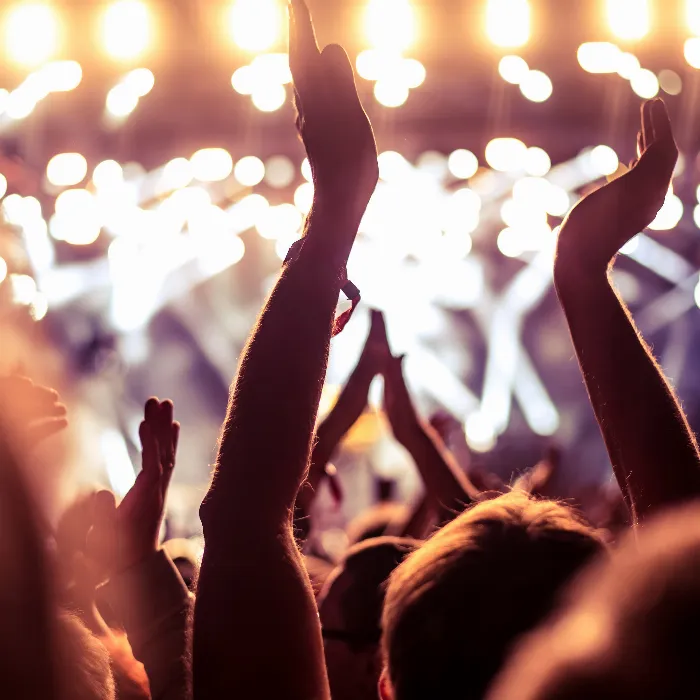Here is an overview of the individual chapters:
Part 01 - "Dream job" concert photographer?
Part 02 - Legal issues
Part 03 - Special features of concert photography
Part 04 - Behavior in the "trench"
Part 05 - The right equipment for concert photographers
Part 06 - Tips and tricks from (concert photography) professionals
Part 07 - Image composition (Part 1)
Part 08 - Image composition (Part 2)
Part 09 - Recommended camera settings
Part 10 - The post-processing
Figure 5.1: BAP on August 24, 2011 at the Ruhr Tent Festival. The right (suitable) equipment, along with photographic skills and a little luck, is crucial to the success of the photos from the concert. Nikon D3S with 4.0/24-120 mm Nikkor at a focal length of 24 mm. 1/200 second, Blender 4.0, ISO 3200.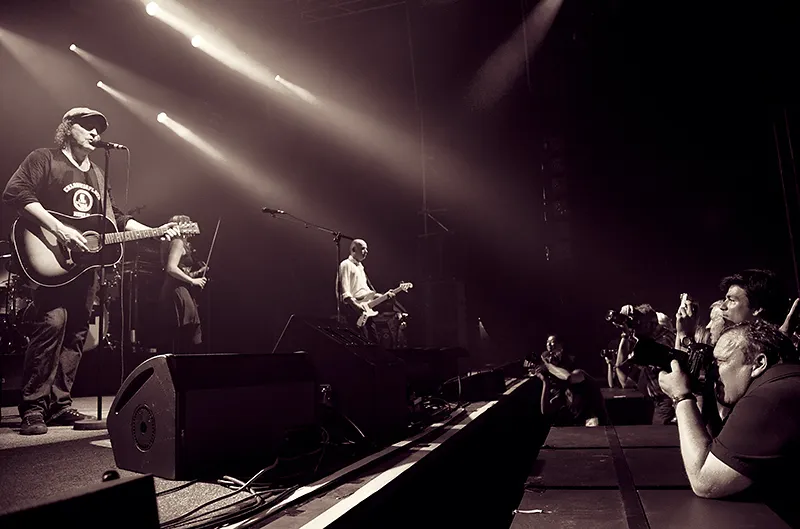
(Photo © 2011: Jens Brüggemann - www.jensbrueggemann.de)
Note: The following recommendations are aimed at professional and semi-professional concert photographers. Of course, not every amateur photographer can be expected to fork out a few thousand euros for a DSLR body suitable for concert photography. Or just under 2,000 euros for a fast telephoto zoom lens.
On the other hand, there are also plenty of dedicated amateur photographers with high standards who own camera equipment that many professional photographers can only dream of.
In this respect, I simply assume at this point that the majority of interested readers will already have quite high standards, because real concert photography (with the possibilities for accreditation etc.) is normally not feasible or only with difficulty for pure amateur photographers (with a few exceptions).
Nevertheless, there are always opportunities (such as at the "Umsonst-und-draußen-Festivals") where non-professional photographers also get the chance to take concert photos. I will therefore make my recommendations with professional standards in mind, but will also give tips for cheaper alternatives. Often the differences are really only of a marginal nature; usually only visible at enlargements, which hardly anyone needs nowadays in the Internet age.
For example, if you only publish your photos on the Internet in a resolution of 400 pixels x 600 pixels, you can confidently do without many professional quality features of your photographic equipment! (Because nobody can see the differences in quality at this size anyway).
However, as a professional photographer who also makes a living from selling his existing photos, I always have to reckon with the fact that a potential customer will sometimes ask for an enlargement of, say, 2m x 3m in impressive quality. And then it's good to have "reserves" and to be able to supply files that make this possible.
5.1 Useful features of the camera
There are a few camera functions that are particularly useful for us concert photographers. These are, for example
- Full-frame sensor
- Low image noise at high ISO values
- Enabling fast, intuitive operation
- handiness/handling
- short shutter release delay
- high continuous shooting speed, which enables fast image sequences
- Fast, precise autofocus
- ample internal buffer memory
- wide dynamic range
- robustness.
Figure 5.2: DSLR cameras with a full-frame sensor are ideal for concert photographers. They offer very high image quality and allow enlargements up to poster size without compromising on quality. However, there are also differences between DSLRs with full-frame sensors: some models are designed for the highest possible resolution, while others offer the possibility of taking pictures even in low light conditions (without clearly visible noise even at high ISO values). The Nikon D3X shown here belongs to the first category (high resolution).
The sister model Nikon D3S or the successor cameras Nikon D4 and Nikon D4S are better suited for concert photography. With all of them, you can confidently set ISO sensitivities of 3,200 or even 6,400 without having to worry that the image quality will visibly deteriorate. This is ideal for concert photography, where often in concert halls or at open-air events in the evening you have to reckon with poor lighting or little available light.
The lens used here is the 2.8/24-70 mm Nikkor. An ideal zoom for concert photography, provided the photographer is right next to the stage (in the press pit), because the wide-angle setting is good for photographing several musicians or even a large part of the stage, while the telephoto setting of 70mm allows you to shoot almost portraits of the musicians moving close in front of you on stage. In addition, the lens is still sufficiently fast for most lighting situations.
(Photo © 2011: Jens Brüggemann - www.jensbrueggemann.de)
Figure 5.3: The size of the camera sensor is also decisive for the photographic quality. However, it is also helpful if you clean it regularly (or have it professionally cleaned). This is especially true if dirt is clearly visible and the photos are to be passed on to the client complete and unedited after a shoot.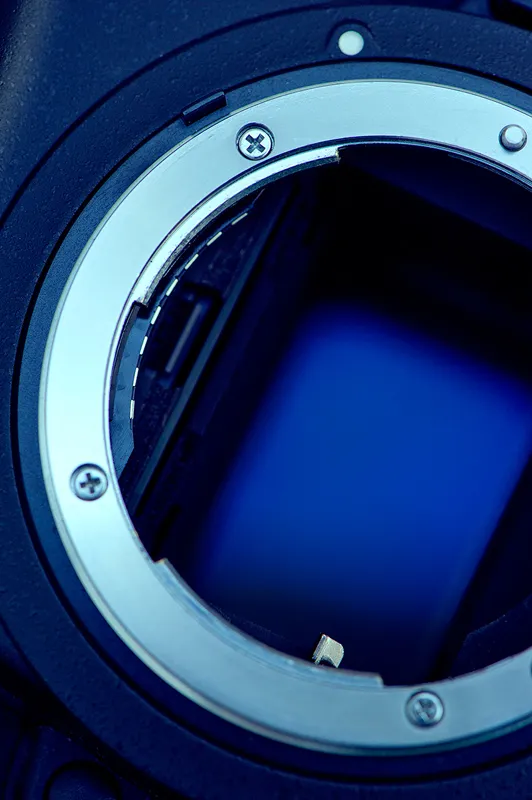
(Photo © 2011: Jens Brüggemann - www.jensbrueggemann.de)
In order to achieve an appealing image quality or to be able to take photos in low light conditions with high ISO values without disturbing, strong image noise, it is advisable to purchase a full-frame camera. Due to the larger sensor area, either more pixels can be accommodated (high resolution) - or fewer pixels with larger distances between them (which enables photography at high ISO values with reduced noise). The second case in particular is of great practical relevance for concert photography, as ISO settings of 3,200 or 6,400 due to low light conditions are by no means uncommon.
Figure 5.4: Comparison of the pixel arrangement with identical sensor size. Because the spacing is larger on the lower resolution sensor (left), the photographer is able to use higher ISO sensitivities in low light conditions (without the image noise being too distracting). However, when using a camera with a high resolution (e.g. Nikon D800 with 36 megapixels or Nikon D3X with 24 megapixels), the light sensitivity should not be set too high. At ISO values of 800 or higher, the image noise becomes clearly visible (and therefore disturbing).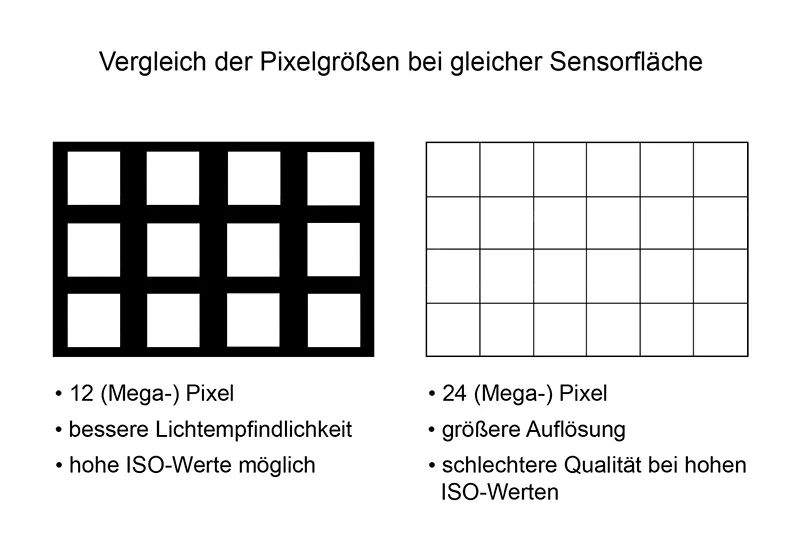
(Sketch © 2010: Jens Brüggemann - www.jensbrueggemann.de)
Fast, intuitive camera operation is a prerequisite for the photographer to be able to adapt to changing conditions without delay. If you decide to buy a new camera, you should therefore make sure in the store beforehand whether you can really familiarize yourself with the handling or whether it is so much different than before that difficulties with the changeover are to be expected.
Interestingly, as I find out time and again at my photo workshops, Nikon photographers don't get on at all with the operating concept of Canon cameras - and vice versa. The fact that the cameras within a brand are usually very similar in terms of operating concept naturally also encourages brand loyalty, because nobody likes to switch to another brand and has to put up with difficulties in adapting and getting used to it, which should not be underestimated.
It's also obvious that the camera shouldn't be too bulky, as there are often crowds in the press pit and we concert photographers often have to change positions quickly so as not to miss special moments of the show. A 35mm DSLR is exactly the right tool for the job! Medium-format cameras, on the other hand, are simply too big and less fast to use.
After all, concert photography is action photography. It is obvious to everyone that fast, intuitive camera operation is a prerequisite for successful results. But a short shutter release delay is just as important.
When the photographer's brain decides to take the picture right now, the brain sends the signal to the hand and the finger presses the shutter release. But then the camera still has to actually take the picture, and this "delay" is called the shutter release delay. Of course, the shorter the delay, the better.
Because during the show, for example, the artist's facial expressions can change quickly, the perfect frame can be lost because the musician has moved, or the lighting can change for the third time within a second (which happens particularly at rock and pop concerts, but rarely at classical concerts). Whoever's camera "reacts" immediately has a clear advantage! (The shutter release delay of my Nikon D4, for example, is 0.042 seconds according to the manufacturer's specifications).
Figure 5.5: A fast autofocus and a short shutter release delay are very important when unplanned and funny situations suddenly arise, as in this photo of Marius Müller-Westernhagen at his concert on December 23, 2008 in Berlin. While the cameras of other photographers were still focusing, photographer Sven Darmer could already hear the reassuring clack of the mirror of his professional DSLR (synonymous with confirmation that he had captured this unique and incomparable photo).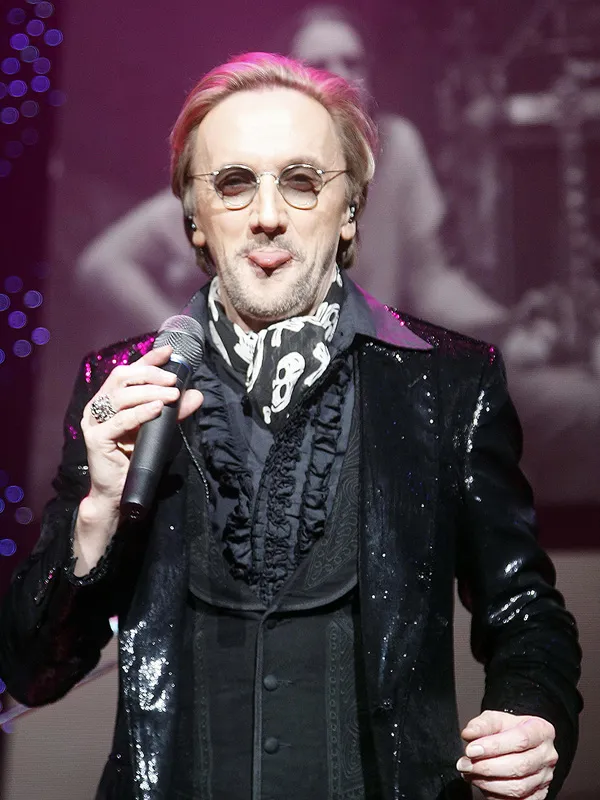
(Photo © 2008: DAVIDS/Sven Darmer - www.svendarmer.de)
A high continuous shooting speed (frame rate; for example Nikon D4: 11 frames/second) is also an advantage. Not that some people now think that it would be helpful to hold your index finger down for as long as possible in order to take a "continuous shot"! That's definitely not the case! (Especially as at some point you will find yourself in a situation where the camera is still saving and the shutter release is blocked and you can't take any new photos). However, "short bursts" of 2-4 photos in a row are definitely recommended, because this way you can pick out the most successful one from the photos taken of a motif.
If you have 2-4 almost identical shots of each subject, you will quickly recognize the subtle differences that always exist between these shots. For example, the artist may have just blinked in one of the photos, while one of the others shows the artist with his eyes open. Or in one of the photos, one of the (backlit) spotlights is shining directly into the photographer's camera, outshining the actual (important) subject (usually the musician), while one of the 2-4 photos has caught the moment when the musician on stage covers the spotlight and stands in the effective backlight. So if you get into the habit of "shooting" 2-4 photos in quick succession instead of just one, you will have a higher hit rate of successful photos.
A fast (and precise) autofocus is also an advantage, because if (with focus priority) the shutter release cannot be pressed because the autofocus is still focusing, irretrievable moments can be missed.
Figure 5.6: It wasn't just luck: when the guitarist caught sight of me while I was focusing on him, he smiled briefly and pointed at me. Thanks to the short shutter release delay of my camera, I was able to capture this "personal" moment. Nikon D800 with 2.8/70-200 mm Nikkor at a focal length of 160 mm. 1/800 second, Blender 5.6, ISO 400.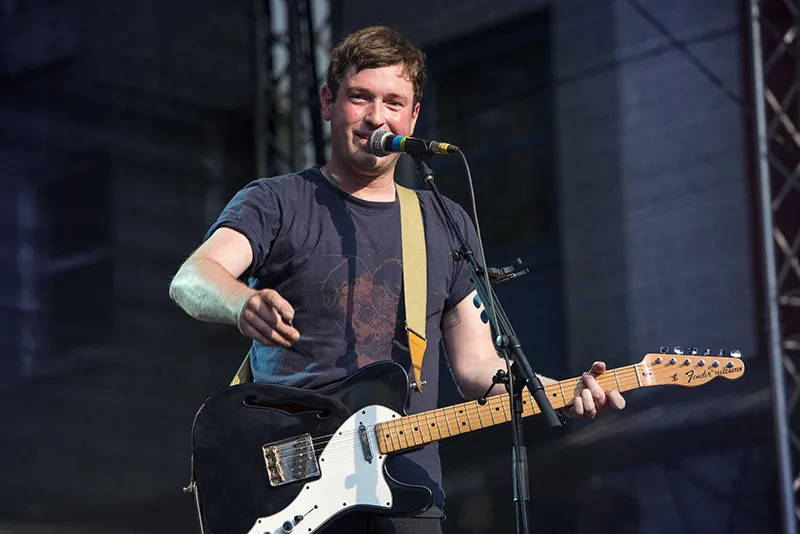
(Photo © 2013: Jens Brüggemann - www.jensbrueggemann.de)
And there is another feature that determines whether the photographer can always take photos when he wants to: the camera's internal buffer memory. It has the function of a clipboard, because it takes longer to save the photos taken to a memory card than to record them in the buffer memory. It therefore prevents data jams. The buffer memory indicates how many photos (taken in quick succession) can be held in the clipboard while the camera is busy saving them.
If the buffer memory is full, nothing works at first; a next photo can only be taken when one of the photos taken and stored in the buffer memory has been completely written to the card (the writing speed of which is also important for efficient operation).
While it can hardly happen with slow image sequences that the buffer memory becomes full, with fast image sequences and large file sizes (i.e. RAWs or TIFFs or less compressed JPEGs) it is more common to have to wait until the image jam is cleared (by writing to the memory card).
The larger the camera's buffer memory, the more high-quality photos can be taken in quick succession. For concert photographers, a large buffer memory is a very important feature! A large buffer memory avoids having to wait before you can take a new shot; an unpleasant moment that almost every concert photographer has experienced ... (due to the typically fast image sequences in concert photography and the many photos that are taken in a very short time).
Figure 5.7: Blackmail on July 12, 2013 at Bochum Total. Because we concert photographers take as many shots as possible in the shortest possible time (we are usually only allowed to photograph the first 3 songs), the camera's buffer memory is a feature that is crucial to ensure that we are always ready to shoot and never miss an important or unusual moment. This is especially true if the show has a lot of "action" and we have found a good shooting position and the stars can be portrayed well.
The Nikon D4's large buffer memory allows up to 100 consecutive images to be captured in RAW format and up to 200 images in JPEG format (Fine, with medium file size). In each case at 12-bit color depth and using a Sony XQD card with 32 GB storage space. For comparison: The Nikon D800 (with a significantly higher resolution) stores up to 17 RAW images or up to 56 JPEG photos (JPEG Fine L). The figures take into account the fact that during "continuous fire" photography, images are already being saved to the memory card, thus increasing the effective number, as the buffer memory is constantly being emptied (by writing to the memory card). Nikon D800 with 2.8/70-200 mm Nikkor at a focal length of 125 mm. 1/500 second, Blender 4.5, ISO 800.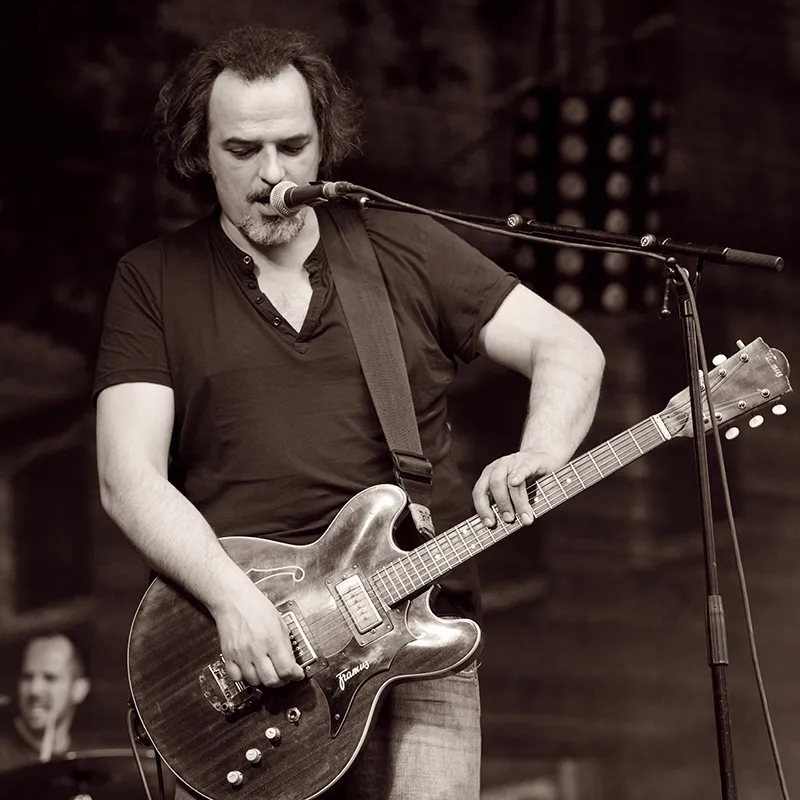
(Photo © 2013: Jens Brüggemann - www.jensbrueggemann.de)
The dynamic range of a camera determines how many f-stops of contrast the camera can process in which detail can still be recognized, i.e. which are neither deep black without detail nor blown out white. As the dynamic range also depends on the ISO setting used, only very few camera owners know the values for this. (1 f-stop means twice the amount of light, or half the amount of light, depending on the direction in which it is taken). The dynamic range is determined in tests and is difficult to verify/trace; the decisive factor is rather the realization that cameras with a high dynamic range are better suited for concert photography (because many brightness contrasts are almost always to be expected during the lightshow and cameras with a high dynamic range are better able to cope with and reproduce them). So if there are two different camera models to choose from and you're not sure which one to go for, opt for the model with the highest dynamic range.
And last but not least, if you want to work with the camera for a long time, it is an advantage that it is as robust as possible. It's not uncommon to (unintentionally) bump into other photographers in the press pit or, in the heat of the moment, bump into a speaker box or the barrier with your cam when changing location, for example. In addition, it is often very humid in concert halls, so waterproofing against moisture can really serve its purpose in concert photography. If you are photographing outside at a festival, there is also always the risk of a summer thunderstorm. Concert photographers with professional housings brave the rain and continue to take pictures, while many "snapshooters" stop taking pictures at the first drop of rain and pack up their cams.
5.2 Lens requirements
Which lenses are best suited for concert photography? Fast zoom lenses are particularly recommended. Of course, it can happen that you have enough (day) light at an open-air festival, but at another event you may have to take photos in a smaller club or a dimly lit event hall (without using a flash unit, of course!). And then the light intensity of your lenses will decide whether you are one of those who can take photos without any problems, or one of those who have to pack up their cameras again or try helplessly with "long exposures" (camera then propped up on the booming loudspeaker box).
So what does "fast" mean?
Lens speed for lenses (in whole f-stops)
1 - 1.4 - 2 - 2.8 - 4 - 5.6 - 8 - 11 - 16 - 22 - 32 - 45 - 64 - etc.
One step to the right means halving the amount of light entering through the lens. For example, a step from Blender 5.6 to 8 means halving the amount of light passing through the lens. Conversely, going from an aperture of 4 to an aperture of 2.8 means doubling the amount of light passing through the lens.
This makes it clear how big the differences in light intensity really are with different lenses. For example, the lenses 4/70-200mm and the 1.4/85mm are to be compared. If you don't value the flexibility of a zoom lens, you are much better off with the 1.4/85mm lens for reasons of speed alone, because it is 8 times as fast as the 4/70-200mm lens (3 steps to the right in the above series of figures; each step to the right means a reduction in speed of 50%, i.e. a halving).
In other words: The photographer with the 4/70-200mm lens needs 8 times more brightness in order to be able to take pictures (borderline; just barely) compared to his colleague with the 1.4/85mm lens.
The photographer with the 1.4/85mm lens needs only 1/8 of the brightness as his colleague with the 4/70-200mm lens.
Of course, this applies under otherwise identical conditions (same camera, same event, same time, same point of view, same ISO setting, same shutter speed).
Figure 5.8: Fast lenses enable photographers to take photos even when their colleagues are already resignedly packing away their equipment or trying to take photos with long exposures and the camera somehow propped up.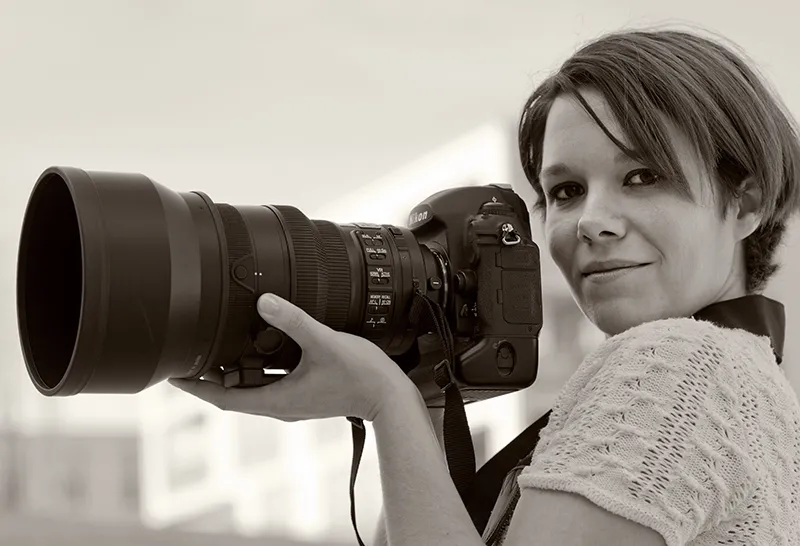
(Photo © 2011: Jens Brüggemann - www.jensbrueggemann.de)
Unlike in many other areas of photography, the use of zoom lenses in concert photography makes perfect sense. They are usually used because photographers are too lazy to move a few meters forwards or backwards. However, unlike in the studio, for example, where this is usually possible without any problems, changing position in concert photography (due to working with a fixed focal length) is associated with disadvantages:
- A change of location is often not even (sufficiently) possible due to the cramped space in the press pit.
- A change of position by the photographer (for example, stepping back to increase the distance to the subject a little) can quickly lead to the gap that has now become free, which guaranteed a clear view of the stage, being quickly closed by another photographer. As a result, the view is blocked.
- If the change of viewpoint is carried out because the fixed focal length used requires more distance, for example because all the band members are presenting themselves to the audience at the edge of the stage, the evasion will inevitably lead to the photographer moving to the side - and thus obtaining a different (lateral) perspective, which may not be optimal.
Speed in particular is crucial in concert photography. Changing lenses, as is often the case when working with fixed focal lengths, takes time - and that's exactly what we concert photographers always have too little of. In this respect, the advantages are clearly on the side of zoom lenses. However, make sure that you only buy very fast lenses; a speed of 2.8 (throughout) is desirable.
However, if you have a camera that allows high ISO settings without excessive image noise, you can compensate for the lack of speed.
Figure 5.9: Zoom lenses have the advantage that you can quickly vary (adjust) the image section without having to change your position. This allowed me to take the ideal portrait of Jan Delay from the press pit. If you decide to use zoom lenses for reasons of practicality, you should think carefully beforehand about which focal length range makes the most sense for concert photography. However, you should not compromise on quality and light intensity! Every manufacturer offers good quality, fast zoom lenses (for example with an aperture of Blender 2.8).
Here I used the 2.8/24-70mm Zoom-Nikkor. It is ideal if you are standing very close to the edge of the stage at a concert. The starting aperture of 2.8 allows you to take pictures even in dim stage lighting and the quality of the imaging performance is beyond question. Nikon D3S with 2.8/24-70 mm Nikkor at a focal length of 70 mm. 1/1000 second, Blender 3.5, ISO 5000.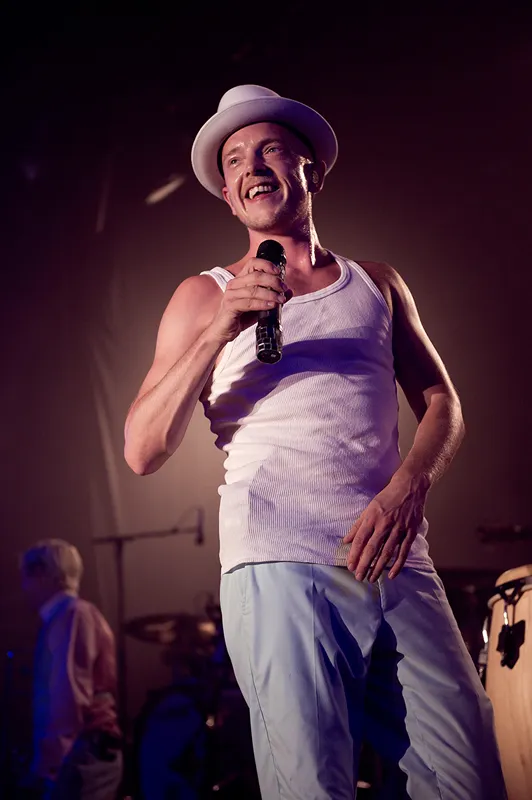
(Photo © 2011: Jens Brüggemann - www.jensbrueggemann.de)
Minimum lens equipment
I usually take a mixture of lenses to the concert. A zoom lens with a maximum initial focal length of 24mm is essential (for example the 2.8/24-70mm or the 4/24-120mm). I also always have the 1.4/85mm portrait telephoto lens with me as a fast fixed focal length. This is extremely fast and can therefore be used in extremely low light conditions; it is also a nice lens for artist portraits, especially as the distance (position of the photographer in the pit to the artist on stage) is very often ideal for this focal length due to the focal length.
At open-air concerts or when photographing from the audience, I usually have the telephoto zoom 2.8/70-200mm with me. It is acceptably fast and also makes it possible to take pictures from a greater distance, with amazing image quality.
For special effects, for example to capture the entire stage or when artists come very close to the edge of the stage, super wide-angle or fisheye lenses are the first choice (for example 2.8/14 mm or 2.8/16 mm fisheye). If you don't want to do without the convenience of a zoom lens in the wide-angle range, we recommend the 2.8/14-24mm.
Figure 5.10: When the photographers are standing in the press pit directly in front of the stage, there are sometimes situations where we are so close to the musicians that only the use of a wide-angle lens allows us to take pictures. So wide-angle lenses should definitely not be missing from a concert photographer's kit! Here the cult rockers Kiss were photographed expressively at their concert in the Berlin Velodrom on June 9, 2008!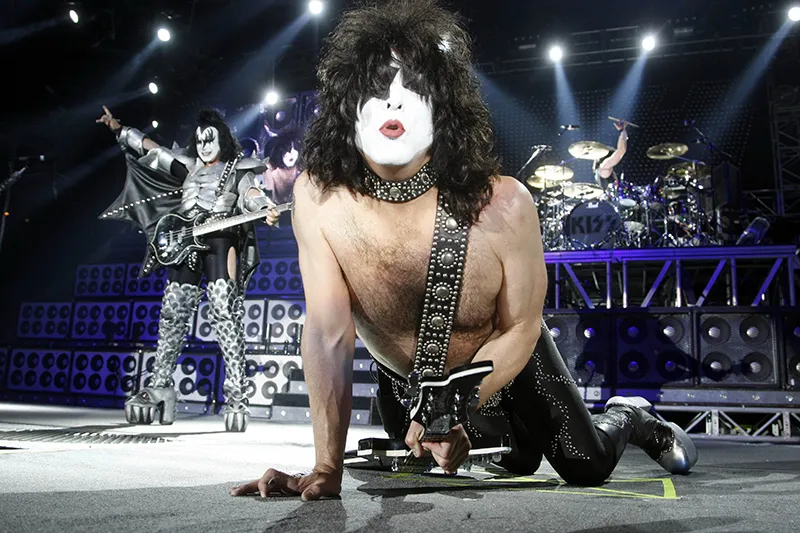
(Photo © 2008: DAVIDS/Sven Darmer - www.svendarmer.de)
Note: Please note that different focal lengths can be used to compensate for different distances to the subject. However, the different focal lengths can also be used very well to create different effects that can be used effectively for creative purposes.
Figure 5.11: Fast lenses are the first choice for concert photographers. However, sometimes compromises have to be made in terms of flexibility (for example, if you can't change your position in the pit, zoom lenses are more practical than fixed focal lengths) and weight (if a photo backpack full of heavy lenses hinders the photographer's work, it's better to choose a few lightweight lenses).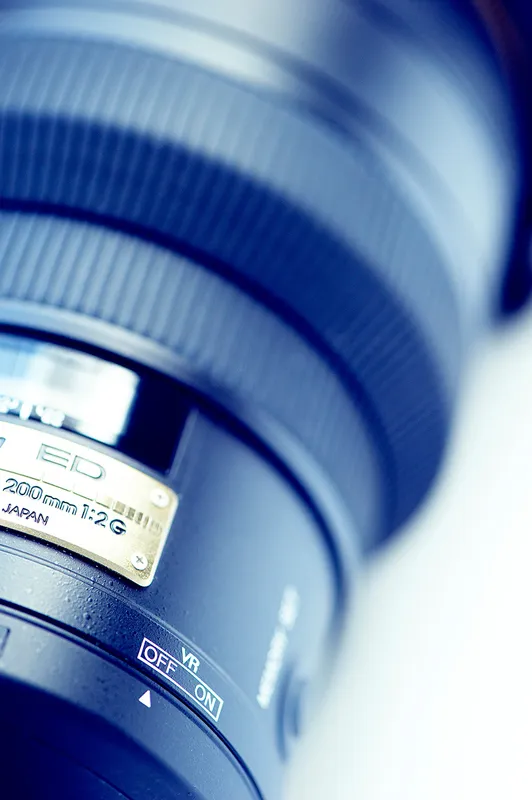
(Photo © 2011: Jens Brüggemann - www.jensbrueggemann.de)
Figure 5.12: If the photographer is not shooting from the press pit but is standing in the middle of the audience, telephoto zoom lenses are the first choice. To ensure that this is not at the expense of light intensity and image quality, you have to dig a little deeper into your pockets. The popular 70-200 mm zooms from the major camera manufacturers cost around 1,800 euros (at least the fast version with an aperture of 2.8).
An expense that not everyone can afford immediately. Only those who are very committed or earn their living with photography will consider such expenditure. The creative advantage of telephoto (zoom) lenses is that they are excellent for separating the main subject (usually one of the artists) from the background, which more or less dissolves into blur.
This is an invaluable advantage, especially with the often unsteady stage set-up, with instruments and event technology in the background, as you can clearly see in this photo. Nikon D800 with 2.8/70-200 mm Nikkor at a focal length of 200 mm. 1/250 second, Blender 3.2, ISO 400.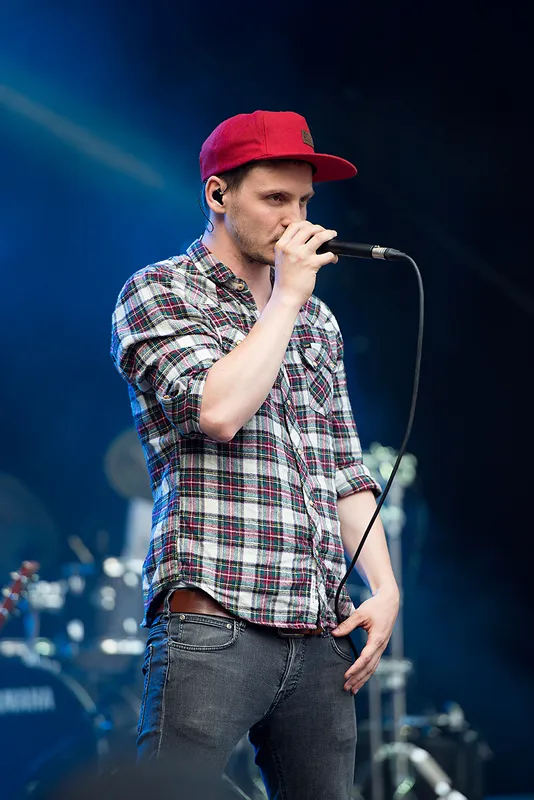
(Photo © 2013: Jens Brüggemann - www.jensbrueggemann.de)
5.3 Memory cards
As already explained above in connection with the camera's buffer memory, memory cards have a not insignificant influence on the speed at which the photos taken are saved - and thus also on the time it takes to be ready to shoot (again) after shooting long series.
A high write and read speed of the memory cards used ensures a smooth workflow: When taking photos, fast memory cards ensure that the camera's internal buffer does not reach its limits, as the temporarily stored images are (quickly) saved to the memory card. When transferring photos to external media or your home computer, fast memory cards (with fast read speeds) ensure short waiting times. For professional photographers in particular, fast memory cards are therefore invaluable when it comes to quickly selecting photos after a concert and sending the best ones to the editorial team via the Internet.
Figure 5.13: Fast memory cards are the be-all and end-all in concert photography. The fact that we only have very little time to take photos means that "continuous firing" is a good thing for concert photographers (and is not frowned upon). If you take several photos of the same subject in quick succession, the hit rate is definitely higher. This is because the probability of catching the right moment (which is mainly determined by the rapidly changing lighting from the spotlights) is significantly higher with "continuous fire".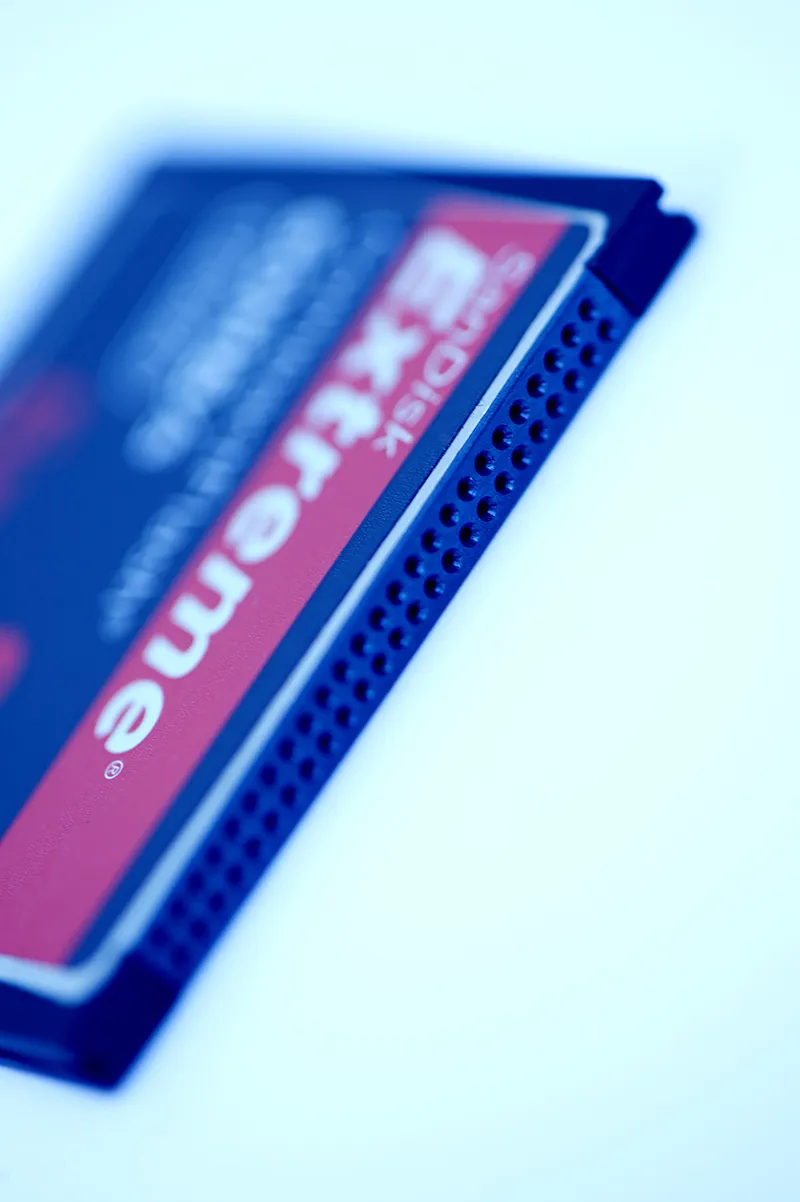
(Photo © 2011: Jens Brüggemann - www.jensbrueggemann.de)
Note: Memory cards should not only be fast, but also extremely reliable! Anyone who has ever had problems with a memory card should either throw it away or at most use it for backup purposes in the camera's second memory card slot (if there is one). But never entrust such a memory card with unique, irretrievable recordings - otherwise you could regret it at some point if the card is no longer readable.
Figure 5.14: Once you have found a good position in front of the stage, every photographer will shoot entire series of the respective musicians in order to select the best picture (with the optimal exposure, the most expressive pose, etc.) afterwards at home on the computer. Fast memory cards help to cope with the large amounts of data that are created in this way. Both when writing the data (when saving the images internally in the camera) and when reading the data (for example via the reader connected to the computer).
Nikon D800 with 2.8/70-200 mm Nikkor at a focal length of 190 mm. 1/250 second, Blender 4.0, ISO 800.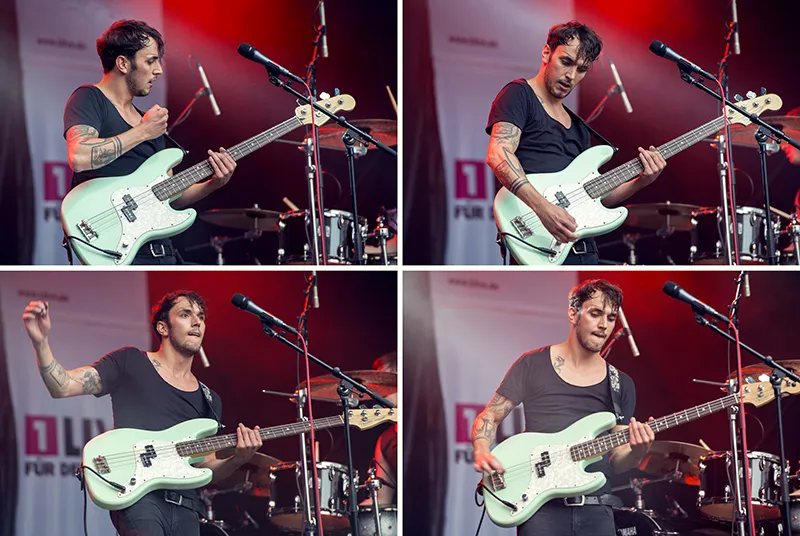
(Photo © 2013: Jens Brüggemann - www.jensbrueggemann.de)
Note: By the way, there are not only differences in speed with memory cards. USB sticks also show extreme differences in the speed of data transfer. We recommend the Corsair GT-USB3.0 sticks. They have a write speed of up to 130 MB/s and a read speed of up to 220 MB/s and are therefore sometimes up to 8 times faster than conventional USB sticks, depending on the model.
5.4 Other useful tools: notepad, system flash, flashlight, ...
However, there is other useful equipment for concert photographers. A notepad with a pen is a must, because it is not uncommon to have to write down the names of the performing bands (especially at festivals where many groups are performing), the order of the performances, guest musicians or, for example, the name of a responsible manager of the band, the concert organizer or another contact person; preferably with a cell phone number and email address, of course.
You should also take a spare T-shirt to change into! This has often saved me from catching a cold or even pneumonia when I've come outside dripping wet after a concert (especially in summer, for example, when the event takes place in a small club that is bursting with people or in a tent where the sun has been beating down all day). The air in many event halls is often stuffy and humid, so that not only the musicians on stage, who are also in the spotlight, but also the audience are sweating profusely.
Although not permitted for the duration of concert photography in the pit, the system flash is nevertheless an important part of the photographic equipment. This may seem illogical at first (it is not allowed to be used during the concert photos), but on closer inspection it becomes clear that it can still do no harm to bring it along. Situations can often arise before or after the actual concert photos (interview with the artists, sound check, photos of the supporting event, etc.) where the system flash may presumably be used. In this respect, it is better to have it with you in case you need it than to be annoyed because valuable motifs are lost due to the absence of the flash.
Figure 5.15: No concert photographer's photo bag should be without earplugs! Anyone who regularly attends concerts (either professionally or as a hobby) and stands very close to the stage in the press pit will be exposed to noise levels that can/will affect their hearing in the long term. This is especially true for us concert photographers, because we are usually standing directly in front of the booming speakers in the press pit.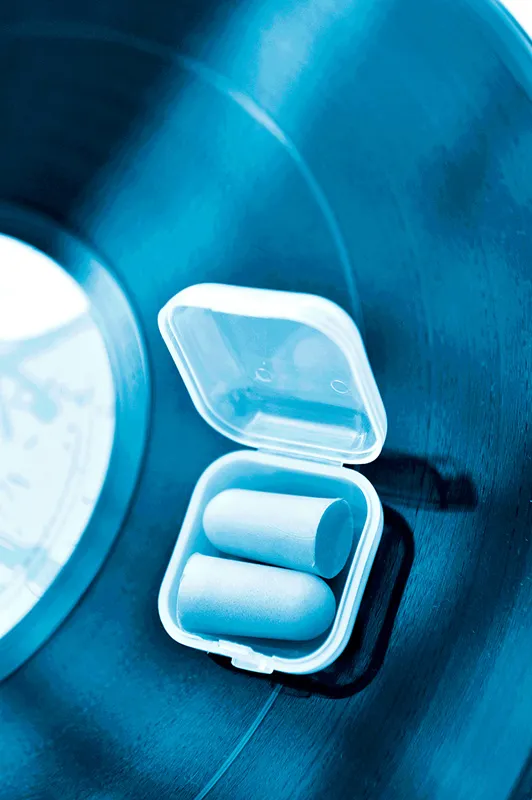
(Photo © 2011: Jens Brüggemann - www.jensbrueggemann.de)
A small flashlight helps, for example when entering the pit before the concert, to locate any tripping hazards (which you should then remember so that you don't stumble over them during the hectic shooting). But make sure that as soon as the concert has started, you don't shine your flashlight around the area (this would immediately alert security).
And at the latest when you leave the festival grounds after the recordings and look for your car in a large unlit meadow, you will appreciate the blessings of your flashlight for a second time! We recommend the M1 flashlight from LED-Lenser. It weighs just 78g and is only 9.7cm long, but it packs as much power as a big one: 170 lumens give this little wonder a light range of up to 150m. Ideal for all concert photographers who want to save weight but still can't do without a powerful flashlight.
Anyone who wants to earn a living from (concert) photography, whether full-time or part-time, also needs their own (professionally designed) business cards. This allows you to quickly pass on your contact details (to managers, musicians, event organizers, fellow photographers, writing journalists, etc.) and make a professional and serious impression. The business card should preferably be designed by a professional graphic designer, even if many of you will now be thinking: "I can do that too!"
However, reality shows time and again that many people have the self-confidence, but not necessarily the real skill or talent for graphic design. So it's better to invest a few euros in hiring a good graphic designer. After all, the business card and the first impression of you as a person are decisive in whether or not contact is established.
Figure 5.16: Especially at music festivals, where many bands perform either one after the other or in parallel on different stages, it is useful to make a note of the order in which the bands performed (and, above all, were photographed). Collecting program booklets also helps! Blackmail - Nikon D800 with 2.8/70-200mm Nikkor with 125mm focal length used. 1/640 second, Blender 5, ISO 800.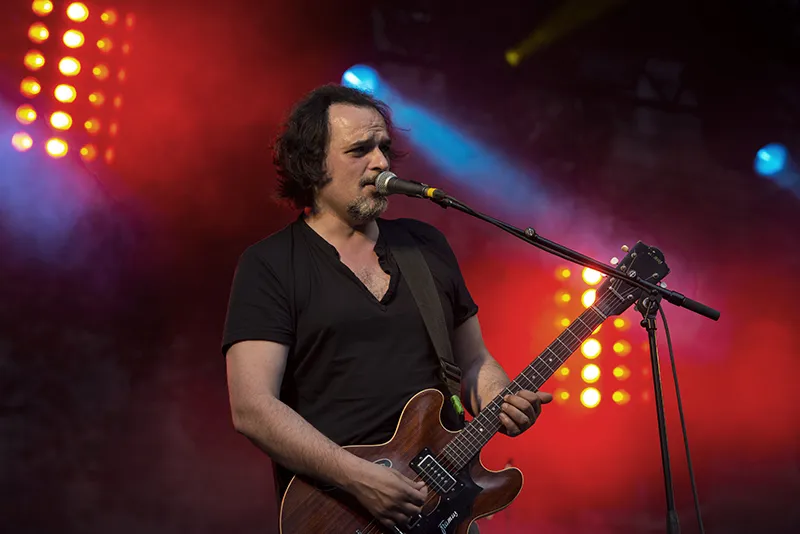
(Photo © 2013: Jens Brüggemann - www.jensbrueggemann.de)
